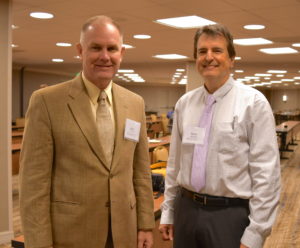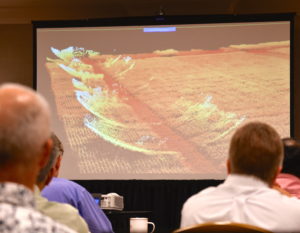Ag experts discuss handling big data in agriculture at Houston conference
Media contact: Blair Fannin, 979-845-2259, [email protected]
HOUSTON – Agricultural experts at a Houston conference praised the advancements in unmanned aerial vehicles, sensors and data-collecting technology used in precision crop production research, but said there are also challenges in how to process vast amounts of information and translate to the farmer.
The conference, “Identifying Obstacles to Applying Big Data in Agriculture,” held Aug. 20-21 covered a broad spectrum of both unmanned aerial vehicles as well as automated ground vehicles equipped with sensor technology used to collect a variety of datasets in crop production.

Texas A&M AgriLife Research and the U.S. Department of Agriculture-National Institute of Food and Agriculture were conference sponsors.

“We need reliable data and to be asking the right questions,” said Dr. Alex Thomasson, conference coordinator and Texas A&M AgriLife Research engineer. “A few agricultural trends as well as technology development in the broader economy have driven the advance of big-data technology use in agriculture.”
For example, Thomasson said, autonomous sensor platforms like UAVs, or drones, are now being equipped with imaging sensors to measure plant traits more efficiently and accurately than manual methods.
“However, while recent reports document high rates of data collection in production agriculture, they also note low rates of data usage,” he said.
Thomasson said big data will have limited value in increasing farm productivity, profitability and environmental risk reduction until there are practical ways to reliably produce timely, actionable information from the data in common applications.
“The keys to success include efficient and effective collection, storage, transmission, analysis and applied decisions based on large amounts of data,” he said. “The conference addressed these major questions that must be answered in order for big data to see broad on-farm adoption.”
Presenters at the conference also talked about “noise” or errors collected by machines misinterpreting data.
“The biggest problem from big data we found is how do you get rid of the noise?” said Dr. Seth Murray, AgriLife Research corn breeder in College Station, who presented “Breeding, Genetics, Phenotyping and Agricultural Big Data.” “Nobody wants to do it. It’s a labor intensive slog.”
However, the potential for unmanned aerial vehicles to take the place of manual labor presents many opportunities.
Murray who actively leads plant phenotyping research examining growth, stress and other development characteristics, said the ability to automate manual tasks such as measuring plant height, calculating grain yield and estimating disease potential is huge.
“It takes an army of student workers to gather this data,” he said. “If we could have vehicles doing this, it would save a lot of time and labor.”
At the moment, there are no standard protocols for collection, storage analysis and translating that information into decisions.
“We need algorithms and a skilled workforce,” said Dr. Rajiv Khosla, Robert Gardner Professor of Precision Agriculture at Colorado State University specializing in precision agriculture.
“We need a next generation of students that understand agriculture and data analytics.”
Khosla, who presented “Agronomic Considerations of Agricultural Big Data,” was among academic and industry experts featured at the conference.
Thomasson said key outputs of the conference were identifying the principal obstacles and solutions to practical and valuable on-farm use.
Attendees heard presentations and then were placed into working groups, making recommendations that will be compiled into a report to be submitted to USDA-National Institute of Food and Agriculture at a future date.
For more information about the conference, visit https://www.agbigdataobstacles.com/ .


